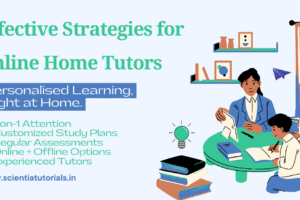Keeping Younger Learners Engaged: Essential Tips for Home Tutors
Tutoring younger learners can be a rewarding yet challenging experience. Engaging children during tutoring sessions is crucial for effective learning, as their attention spans are often shorter than those of older students. Home tutors must employ creative strategies to keep younger learners focused and motivated. This article explores essential tips and techniques for home tutors to foster engagement and make learning enjoyable for their young students.
Understanding the Importance of Engagement
Before diving into specific strategies, it’s essential to understand why engagement is critical in the learning process, particularly for younger children. Engagement enhances retention and comprehension, making it easier for children to grasp and remember new concepts. Furthermore, when children are engaged, they are more likely to participate actively, ask questions, and explore subjects in depth. This creates a more dynamic and productive learning environment.
1. Build a Positive Relationship
Establish Trust and Rapport
A solid rapport between the tutor and the student is the foundation of effective tutoring. Younger learners are more likely to engage in lessons when they feel comfortable with their tutor. Take the time to build trust by showing genuine interest in their lives, hobbies, and interests. This connection helps students feel valued and understood, making them more willing to participate in sessions.
Use Positive Reinforcement
Celebrate the small victories to encourage young learners. Positive reinforcement, such as verbal praise, stickers, or small rewards, can motivate children to stay engaged and strive for success. Recognizing their efforts fosters a sense of accomplishment, which enhances their desire to learn.
2. Incorporate Interactive Learning Activities
Hands-On Learning
Younger learners often respond well to hands-on activities. Incorporate games, experiments, and interactive lessons that allow students to manipulate materials or engage in physical movement. For example, if teaching math concepts, use counting blocks or colorful counters to make abstract ideas more concrete.
Educational Games
Integrate educational games into your tutoring sessions. Games are a fun way to reinforce concepts and keep students engaged. Choose games that align with the subject matter, whether board games, card games, or online interactive activities. These games make learning enjoyable and competitive in a healthy way.
3. Utilize Technology Wisely
Interactive Apps and Websites
Leverage technology to enhance engagement. Many educational apps and websites are designed specifically for younger learners. These platforms often feature interactive elements, animations, and rewards that capture children’s attention. Use technology as a supplementary tool to reinforce lessons and provide an interactive learning experience.
Digital Storytelling
Introduce digital storytelling tools to make lessons more engaging. Encourage students to create their own stories using multimedia elements, such as images, sound, and video. This not only enhances their creativity but also reinforces language and comprehension skills.
4. Make Learning Relevant
Connect Lessons to Real-Life Situations
Young learners are more engaged when they can relate what they are learning to their everyday lives. Whenever possible, incorporate real-life examples and applications of the concepts being taught. For instance, when discussing fractions, use pizza or cake slices as visual aids to illustrate how fractions work in a relatable way.
Encourage Questions and Curiosity
Foster a sense of curiosity by encouraging students to ask questions. Create an open environment where they feel comfortable expressing their thoughts and inquiries. This not only keeps them engaged but also helps deepen their understanding of the material.
5. Vary Your Teaching Techniques
Use a Multisensory Approach
Younger learners often benefit from a multisensory approach that involves visual, auditory, and kinesthetic elements. Incorporate various teaching methods to cater to different learning styles. For example, use visual aids, storytelling, music, and hands-on activities to create a dynamic learning experience that resonates with all students.
Incorporate Movement Breaks
To combat restlessness, incorporate short movement breaks into your sessions. Allow students to stand, stretch, or engage in quick physical activities between lessons. This not only helps refocus their attention but also promotes physical well-being.
6. Create a Structured Yet Flexible Environment
Establish a Routine
Young learners thrive on routine and structure. Establish a consistent schedule for tutoring sessions, including a clear outline of what topics will be covered. This predictability helps students feel secure and ready to learn. However, be open to adjusting the schedule as needed based on the child’s engagement levels.
Allow for Flexibility
While a routine is essential, be prepared to adapt your approach based on the student’s needs and interests. If a particular topic or activity isn’t resonating with them, don’t hesitate to switch gears. Flexibility demonstrates your responsiveness as a tutor and can help maintain their interest.
7. Foster a Love for Learning
Make It Fun
Infusing fun into tutoring sessions is vital for keeping younger learners engaged. Incorporate storytelling, humor, and creative activities that spark joy in learning. Use props, costumes, or theme-based lessons to make the experience memorable and enjoyable.
Encourage Exploration and Creativity
Promote a love for learning by encouraging students to explore subjects beyond the curriculum. Allow them to ask questions, investigate topics of interest, and express their creativity through projects or presentations. This autonomy fosters a sense of ownership over their learning journey.
8. Communicate with Parents
Keep Parents Informed
Regular communication with parents can significantly enhance a child’s learning experience. Provide updates on their child’s progress, areas of strength, and suggestions for continued learning at home. This collaboration reinforces the importance of education and keeps parents engaged in their child’s development.
Seek Parental Support
Encourage parents to participate in their child’s learning process. Provide them with resources and activities they can do together at home. This partnership not only benefits the child but also strengthens the home-school connection.
Conclusion
Engaging younger learners during tutoring sessions requires a combination of creativity, flexibility, and genuine connection. By building positive relationships, incorporating interactive learning activities, utilizing technology wisely, and making lessons relevant, home tutors can create an enriching educational experience for their students. Remember that every child is unique, so be willing to adapt your approach to meet their individual needs. With these strategies in mind, tutors can foster a love for learning that extends beyond the tutoring session, setting the foundation for lifelong education.



